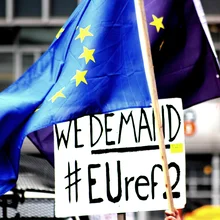
Deal misfires expose risk of contingent hedging
Banks hike premiums on deal contingent swaps amid Brexit uncertainty

Need to know
- A high-profile M&A deal failure has spooked banks offering deal contingent swaps, which have become a more common hedging tool in recent years.
- Experts predict that price premiums for these hedges will rise as dealers begin to weigh up exchange rate volatility and Brexit uncertainty.
- Any price rise may halt momentum in a market that has shown strong demand, in part fed by a spate of public-to-private deals for UK companies that appeared cheap thanks to weak sterling.
- Deal contingent hedging has also become popular in less traditional sections of the market, namely infrastructure and project finance.
- Such deals are more opaque and harder to price accurately, though.
Banks involved in a deal contingent swap with a counterparty named after the Greek god of the sun might have guessed there was a risk of getting burnt.
When Apollo Global Management agreed a £3.3 billion ($4.1 billion) purchase of UK packaging company RPC Group in January this year, the US private equity firm hedged its foreign exchange exposure with five investment banks, according to sources familiar with the deal.
But the surprise failure of the takeover in March left the five banks facing potential losses from Apollo’s now-terminated deal contingent swaps.
The banks got lucky, as it happened. Favourable moves in the exchange rate gave them a windfall on their hedges. However, the episode has provided a reminder of the risks these instruments can pose, and has prompted dealers to adjust premiums.
“For public deals, pricing on deal contingents has increased a bit and there are a reduced number of players due to what happened in March,” says Benoit Duhil de Benaze, head of private equity and corporates at hedging adviser JCRA. “It wasn’t that bad for the banks involved but it’s created a precedent that there is risk associated with these deals and so some banks are more cautious with underwriting deal contingents on public transactions now.”
The move reverses a prolonged period during which premiums on deal contingents had tightened amid fiercer competition in the market. Keen to exploit new seams of business in this lucrative area, banks are now offering hedges in infrastructure and project finance transactions. These non-traditional deals could bring additional risk, though.
Contingency plan
Deal contingent swaps enable firms to hedge adverse movements in, say, exchange rates or interest rates over a period of time. They differ from standard swaps in that the instrument is dependent on the successful completion of an underlying transaction – typically a merger or acquisition.
If the M&A deal completes as planned, the hedge is settled as normal on completion date. If the deal falls through then the hedge terminates at no cost to the purchaser and with no obligation for either counterparty to settle it. Any mark-to-market change in value up until that point is extinguished.
The appeal for the purchaser is a risk-free hedge in exchange for up-front payments. The appeal for the bank is a juicy premium on a trade that stays on the books for a limited period of time and thus attracts lower regulatory capital. The premium is the percentage of the price of the relevant at-the-money FX option.
Banks can manage the risk of the product by the portfolio effect of a large book of trades, or with hedges such as FX forwards. However, problems can arise if a swap terminates and the bank is left exposed to a naked hedge. Given the large size of typical deals, banks can face substantial losses from a failed transaction.
Deal contingents are becoming more common. A hedging adviser reports a 75% average increase in the number of deal contingent trades they are working on compared to this time last year. One estimate puts the proportion of transactions using deal contingent foreign exchange hedges at around 30% in cross-border deals involving private equity.
The rise in activity has tempted more banks to enter the market. Insiders say large commercial banks that traditionally did the leverage financing now also compete to offer the deal contingent swap.
A typical transaction will now see two to three banks vying to be the contingent swap provider, or up to eight for multi-billion dollar deals or complicated hedges. As the market has become more active, smaller deal sizes are now more widespread.
“The market has become so crowded that some of the banks active in this space have started offering deal contingents to smaller sized funds, which means that you see more and more deal contingent transactions for much lower notional,” says the hedging adviser.
“For example, we’ve worked on transactions that are probably equivalent to $40–50 million, whereas the minimum deal contingent transaction size used to be in the region of $200 million five years ago – there’s so much competition for deal contingents today.”
A popular trade in recent years has been to hedge movements in sterling. With sterling’s relative weakness against the US dollar, UK assets have been targets for private equity funds. But purchases denominated in euro or US dollar could easily see FX movements of 10% in either direction owing to Brexit-related volatility between agreeing a deal and closing it.
Greater volatility has bolstered demand for contingent protection on the purchase price. Given the risk, the hedging adviser believes only two to three banks can handle the risks involved in a large UK public-to-private deal contingent in today’s market.
Jean-Philippe Castellani, head of structured finance hedging at Societe Generale, says: “More clients are concerned about what’s going to happen in the market due to Brexit and that’s generated more deal contingent trades than if there hadn’t ever been a Brexit referendum.”
“Clients who could have had an attitude of benign neglect in sterling moves now have to pay more attention because of the erratic market moves both on FX and interest rates,” he adds.
Is the price right?
But the extra uncertainty means the prices of these hedges are also expected to increase.
According to a risk solutions expert at an international investment bank, deal contingent market prices are too tight and don’t accurately reflect the risks involved in such transactions. In particular, market volatility isn’t viewed to be in line with Brexit uncertainty and its impact on sterling. Accordingly, prices are expected to widen.
“We use implied volatility to calculate the premium we would charge on a deal contingent but market volatility is generally low right now. So you’re charging less and less for deal contingents despite the fact that market uncertainty is going up and up,” the expert says.
“For example, if I’m doing a transaction with sterling on one side and that transaction goes over the expected Brexit period then I’m on risk and will have to take that into account in my pricing.”

Market uncertainty can be a factor in the failure of M&A deals – but it is not the only factor. In the case of Apollo’s aborted takeover of RPC, the deal failed because a rival public company Berry Global Group outbid the private equity suitor. Fiat Chrysler’s takeover of rival carmaker Renault was canned this year after the US firm complained of adverse political conditions.
One bank has since adjusted its deal contingent pricing to reflect such deal failures. “We’ve seen a lot of these M&A transactions failing so we’ve certainly become more jittery when it comes to offering deal contingents, and we expect prices to widen a little to take that into account,” says the risk solutions expert at the bank.
Others say they saw usually active banks take a cautious stance in UK public-to-private deals after the Apollo failure. One estimate puts the premium increase at around 20%. At least two dealers say they decided not to get involved in the deal contingent linked to Apollo’s M&A, as they believed the risk of deal failure to be too high.
A source at a European investment bank warns that another big deal failure could cause further price widening.
“It’s a pretty mature business and appetite from banks in terms of offering these products will continue increasing – until there is some kind of hit like the Apollo situation. If that happens then the market will slow down to digest that hit,” the source says.
Pet projects
Market uncertainty may be driving up the price of M&A-related hedges, but it’s also helping to usher in greater adoption of deal contingents in less traditional areas of the market – such as infrastructure and project finance.
Rishin Patel, head of project finance and infrastructure at JCRA, says he’s had a growing number of discussions with clients about the potential use of deal contingents within infrastructure projects like offshore wind farms in order to mitigate interest rate, FX and steel price risk. Offshore wind projects typically involve a large steel component.
“We often discuss various mechanisms of pre-hedging to remove financial market risk from any project at the earliest opportunity but deal contingents probably made up 20–30% of those discussions in the past whereas now they make up the majority of them,” Patel says.
While M&A deal contingents still dominate, SG’s Castellani highlights that the proportion of infrastructure deal contingents within the market has grown over the past 12 months. Such deals represent around a quarter of total activity now, he says.
“Absolutely there is more interest for deal contingents within the context of infrastructure deals,” he says.
The current low interest rate environment has encouraged firms to use deal contingent hedging to lock in low rates linked to project finance. Unlike traditional M&A transactions, where FX hedging dominates, infrastructure projects tend to focus on hedging interest rate risk given the long-dated nature of such transactions.
For example, offshore wind farm projects can take up to 15 years to be completed – with any rise in interest rates affecting the cost of financing or refinancing the underlying asset.
“We’ve certainly seen more requests from clients to lock in interest rates,” says the risk solutions expert at the international investment bank. “Although there’s not much upside to locking in rates now if they continue to decline, there’s plenty of upside if rates increase and potentially put the project in question at risk.”
Infrastructure deal contingents can also involve larger outstanding notional amounts than their M&A cousins – particularly in the renewable sector where pre-hedging €1 billion ($1.1 billion) for 15 years is not uncommon, says SG’s Castellani. For example, the French bank was involved in a deal contingent transaction last year for two offshore wind farms in Belgium for around €1 billion of debt. The transaction was pre-hedged with a deal contingent interest rate swap in May last year and eventually closed in December.
Opaque risks
Infrastructure deal contingents may be larger, but so is the task of pricing and risk-managing them. To price the hedges, banks have to assign a probability that the underlying transaction goes through. For M&A deal contingents, this probability assessment is usually based on a sales purchase agreement (SPA) – a piece of documentation that effectively highlights what the contingency risks for a specific transaction might be.
For example, banks typically assess the regulatory environment, the level of shareholder support, and the risk of a competing bid – as well as conduct quantitative analysis on the target company’s stock price – in order to price the deal contingent linked to the underlying M&A transaction.
However, for some infrastructure deal contingents – such as greenfield renewable projects – this process is made harder due to a lack of SPA documentation, with infrastructure deal contingents thus involving a higher level of due diligence. For example, banks often have to conduct additional on-site due diligence in order to assess construction risk, land issues and labour approvals.
“In some project finance transactions there is no such thing as an SPA so defining what the contingency risks are can be trickier,” says JCRA’s Patel.

This extra due diligence means banks can charge higher premiums for deal contingents in this space. And as there are fewer banks able to offer deal contingents on project finance, there is less competition pushing down prices.
There are also potentially more opportunities for dealers. Banks providing M&A advice and lending are often first in line to be on the deal contingent swap, but as many projects are financed from non-bank sources like infrastructure funds, the door is open to the best swap provider for the job.
The risk solutions expert warns there will always be risks involved in the underlying transaction which banks and counterparties aren’t aware of – such as problems with construction and the chosen suppliers, along with various regulatory approvals – regardless of how much due diligence they undertake.
The longer dated nature of these hedges also has implications for banks’ regulatory capital. As the deals can be more expensive in terms of risk-weighted assets, banks may find this cost eats into their margins.
Five notable recent M&A deals
Merlin Entertainments – £5.9 billion
Private equity firm Blackstone agreed in June to buy Merlin Entertainments, which runs theme parks and tourist attractions across the UK. Blackstone has teamed up with Canada Pension Plan Investment Board and KIRKBI, an investment vehicle controlled by the Lego brand’s founding family. Merlin attracted 67 million visitors to its attractions in 2018, and generated revenue of £1.7 billion.
Cobham – £4 billion
US buyer Advent International is set to swoop for UK aerospace and defence firm Cobham in a deal announced in July. Similar to the abandoned attempt by Fiat Chrysler to buy Renault, the takeover may face political resistance. Cobham’s 2018 profit was £155 million on revenue of £1.86 billion.
Inmarsat – $3.4 billion
Inmarsat, a UK satellite company, is likely to return to private hands after a consortium including Apax Partners and Warburg Pincus agreed to pay $7.21 per share for the business in March.
BCA Marketplace – £1.9 billion
UK-based TDR Capital agreed to acquire BCA Marketplace, second-hand car sales market, in June. BCA, which runs the website webuyanycar.com, generated revenue of £3 billion in the financial year to March 2019. The offer is for 243 pence per share.
Ei Group – £1.27 billion
Stonegate Pubs bid for rival UK pub chain, Ei Group, in a July deal worth 285 pence per share. Stonegate Pubs is owned by TDR Capital.
Editing by Alex Krohn
This article first appeared on sister website Risk.net.
Only users who have a paid subscription or are part of a corporate subscription are able to print or copy content.
To access these options, along with all other subscription benefits, please contact customer services - www.fx-markets.com/static/contact-us, or view our subscription options here: https://subscriptions.fx-markets.com/subscribe
You are currently unable to print this content. Please contact customer services - www.fx-markets.com/static/contact-us to find out more.
You are currently unable to copy this content. Please contact info@fx-markets.com to find out more.
Copyright Infopro Digital Limited. All rights reserved.
As outlined in our terms and conditions, https://www.infopro-digital.com/terms-and-conditions/subscriptions/ (point 2.4), printing is limited to a single copy.
If you would like to purchase additional rights please email info@fx-markets.com
Copyright Infopro Digital Limited. All rights reserved.
You may share this content using our article tools. As outlined in our terms and conditions, https://www.infopro-digital.com/terms-and-conditions/subscriptions/ (clause 2.4), an Authorised User may only make one copy of the materials for their own personal use. You must also comply with the restrictions in clause 2.5.
If you would like to purchase additional rights please email info@fx-markets.com
More on Risk Management
Four more banks join CLSNet
Bilateral payments netting service using distributed ledger tech now has nine firms live
Investment Association calls for standardisation of FX reject codes
The 13 new high-level categories will allow rejection causes to be remedied quicker
FX HedgePool goes live with three buy-side firms
Two US buy-siders trade with European firm on peer-to-peer utility created for them to source liquidity from each other
BIS calls for wider adoption of FX Global Code
Yet some industry participants question the benefits of asset managers signing up to the voluntary principles-based document
Refinitiv pledges FX brokerage to Australian bushfire relief
The area already burned is triple the size of the land destroyed by the 2018 California fires
Morgan Stanley more than doubles Q4 Ficc revenues
All US banks see Ficc revenues improve substantially in Q4 versus a year ago
Colombia culls external reserve manager to boost competition
From 2016–18, the central bank reduced the number of institutions from seven to six
Cboe plans comeback in crypto markets
US exchange plans to offer crypto derivatives after previous attempts at regulatory approval to list crypto ETFs thwarted








